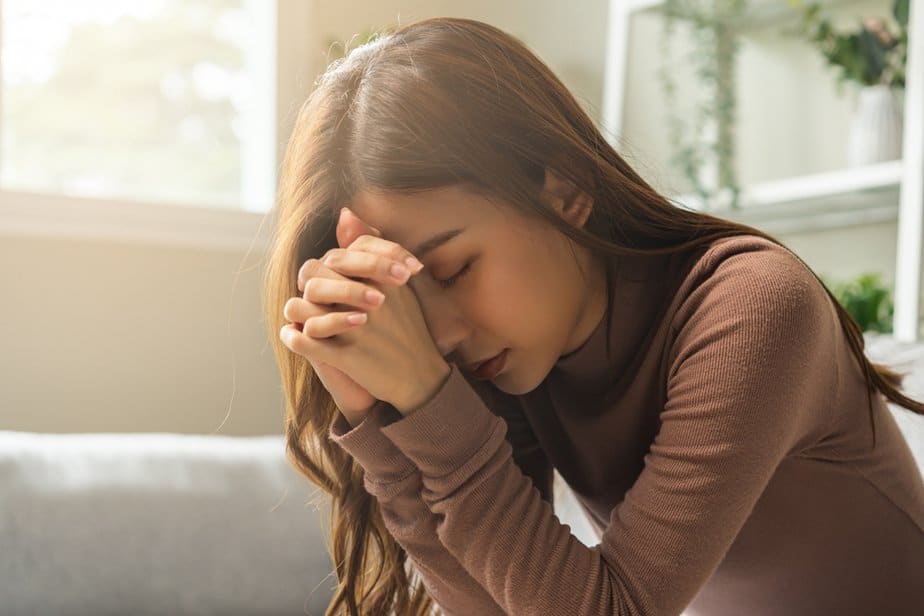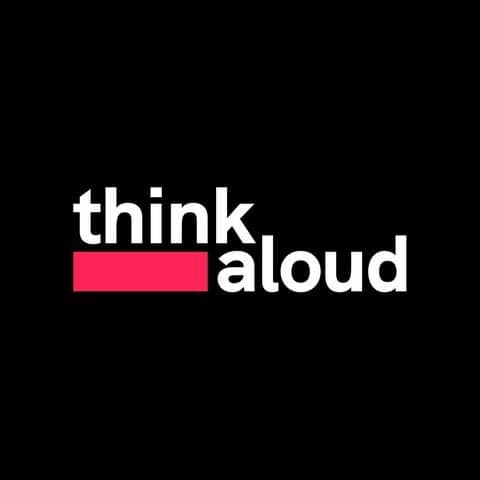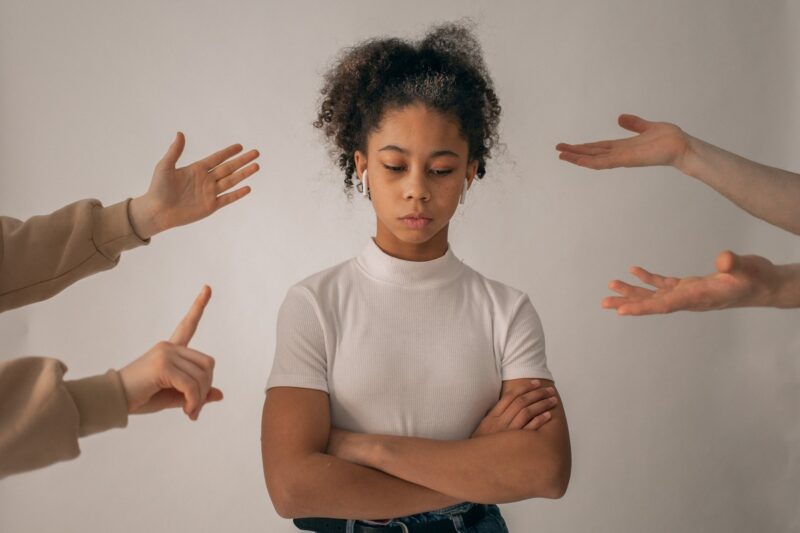Depressed Body Language: 12 Nonverbal Signs Of Depression

Depression might be one of the most common mental health problems, affecting over 260 million people worldwide. Sadness comes and goes depending on the circumstances, but depression lingers for longer and causes hopelessness, anger, and loss of all enjoyment. What are depressed body language signs?
“How are you?”
“I’m fine.
“How are things going? How are you feeling?”
“Yeah, everything’s fine, don’t worry.”
Generally speaking, the people we talk to on the regular give the same answers because that’s the norm and that’s what we expect them to answer when we ask them these questions. We struggle to detect depression because we’re used to people telling us they’re fine even when they’re not.
Now, that’s where body language plays a part. Body language refers to nonverbal signals and cues we use to communicate with each other. Words are great, but our body language reveals more information than we’re willing to reveal. When we observe someone’s body language, we’re able to detect subtle signs.
We all experience negative emotions, but that doesn’t mean that we’re all depressed. When you’re trying to figure out whether you or the people you’re close to are showcasing signs of depression, you might want to do some research on depressed body language.
No single symptom alone indicates that a person is depressed which is why we’re going to discuss the twelve most common body language signs that may indicate a person is suffering from depression.
12 depressed body language signs that point toward a problem

1. Poor posture
Poor posture might be one of the most obvious signs of depression. More often than not, people who are depressed sit or stand with their shoulders bent forward and slumped. When you look at them, they look like they’re going to break apart at any moment.
Poor posture can be a result of a bad habit or a health problem, but when combined with a couple of other depressed body language signs, poor posture typically means that something’s wrong.
People with poor posture might not even be aware of what they’re doing and that’s why you might want to offer them the opportunity to speak when they’re ready.
2. Droopy eyelids
Oftentimes, droopy eyelids are a result of a medical problem and that’s why you might not draw the connection between the appearance of the eyes and depression. People who are depressed, though, experience a myriad of physical changes one of which is depressed eyes.
Depressed eyes are defined by droopy eyelids, a glassy appearance, prolonged eye contact or lack thereof, and a reduced blinking rate. Glassy eyes occur due to frequent crying, for example.
People who opt for prolonged eye contact crave connection and understanding, while people who avoid eye contact reflect feelings of shame, guilt, or a desire to avoid social interactions.
3. Mouth curved downward
People who are depressed aren’t always sad, but they’re known to showcase the typical facial expression of sadness all the time. When you’re talking to someone who might be depressed, you’re probably going to notice the shape of their mouth curving downwards even when they’re trying to smile.
A sad smile with a mouth curved downward seems to be quite a common nonverbal sign of depression. At the end of the day, people who are depressed spend most of their time frowning and they’re probably not even aware that they’re making a sad face. And they’re probably trying to hide their true emotions.
4. Furrowed brows

People who suffer from depression appear miserable at all times. With teary eyes, downturned mouths, and furrowed brows, they typically look like they’ve been crying for the past two weeks (and they probably have been!).
When you’re talking to someone with furrowed brows, you might want to observe the rest of their face, too. Furrowed brows can be a sign of anger and aggression, depending on the circumstances.
When combined with the rest of the depressed body language signs, though, furrowed brows almost always mean sadness and disappointment.
5. Lack of eye contact
Whenever we’re talking about physical symptoms of depression, we do need to address the lack of eye contact. Some people who are depressed might show signs of prolonged eye contact because they’re actively seeking support, connection, and understanding.
They’re on the verge of exploding and they’re aware that they need someone to help them. Other people who are depressed, though, end up showing signs of lack of eye contact because they’re ashamed of what they’re going through.
They’re trying to hide their emotions and run away from whatever they’re experiencing. They think they’re better off without anyone knowing about what they’re going through.
6. Head inclined down or to the side
When you’re talking to someone who might be depressed, you’re going to notice that they’re physically struggling to keep their head held high. We’d argue that most depressed people showcase signs of putting their head down, slightly forward, or to the side.
We’re not sure why that happens, but we can assume that the position of their head depends on their overall mood. When they’re sad, they’re more likely to keep their head down and hide their faces. When they’re talking to someone who holds authority over them, they’re likely to keep their head to the side.
7. The tone of the voice

We can’t forget about the tone of the voice, right? Depressed people might not want to talk about what they’re going through, but the tone of their voice (even when they’re talking about everyday things) reveals more information than one might think.
First things first, you might notice that they’re speaking in a lower voice and that you’re sometimes struggling to hear them. Furthermore, they’re probably speaking with a specific cry in their voice that indicates the sadness and frustration they’re going through.
Finally, the voice of a depressed person sounds a little hoarse and slightly cracks from time to time due to crying.
8. The way of speaking
When you’re done analyzing the tone of their voice, you might want to pay attention to the way they’re speaking, too. We’re talking about the specific vocabulary they’re using, whether or not they’re struggling to get the words out of their mouths, and whether or not they’re emotional when they’re speaking.
People who are depressed tend to overlook the power of vocabulary and opt for simple statements and short sentences that don’t require too much work. Moreover, they’re known to sound quite robotic when they’re talking about their everyday activities because they’re struggling to articulate their words.
9. Lack of concentration
Depression can drain the person’s energy to the point where they’re unable to concentrate, focus on the things that matter to them, or participate in everyday activities.
You might notice the person becoming less and less active, complaining of getting tired much of the time, or experiencing fatigue no matter how much sleep they’re getting. You might also notice that they’re suddenly leading a sedentary lifestyle.
Depression can kill the person’s will to do anything they enjoyed doing beforehand and that’s why they need others to step in and check in on them. You carry that responsibility from the moment you notice that they’re struggling to focus, lacking concentration, and stepping away from their hobbies.
10. Low energy

Depressed people tend to suffer from low energy, too. Depending on the circumstances, they might notice they’re sluggish and fatigued regardless of how much sleep and rest they’re getting on the regular. Their gestures, mannerisms, and speech might start to drag and they might lack overall vibrancy.
Depression fatigue refers to the physical sense of having no energy within your body no matter what you do. Some people experience depression fatigue from time to time, but others never stop having the feeling of not being able to achieve anything during the day.
Symptoms of depression fatigue are weakness, difficulty concentrating, lack of motivation, muscle aches, and whole-body exhaustion.
11. Physical agitation
Depression can cause all sorts of changes in a person’s body language. You might notice them showing signs of physical agitation, restlessness, and inner turmoil. You might see them pacing, foot tapping, and trembling whenever they’re trying to have a conversation or complete a task.
Depressed people experience trouble sitting still and focusing on whatever they’re doing at the moment. Whether they’re getting up and sitting down all the time, fidgeting, or looking around the room trying to find something to concentrate on, there’s a chance they might be suffering from depression.
12. Anger
While that might not be something you want to hear, depressed people are known to become angry and physically aggressive, too. They are unable to regulate their behavior and that’s why they might end up feeling overwhelmed and acting up.
Someone with no history of aggression might start physically or verbally attacking others. Pharmacological management helps control symptoms of anxiety and depression, but you might struggle to get them the help they need for their aggressive outbursts.
When you notice two, three, or more depressed body language signs in someone you’re close to, make sure you offer them a helping hand and get them the professional help they need.






